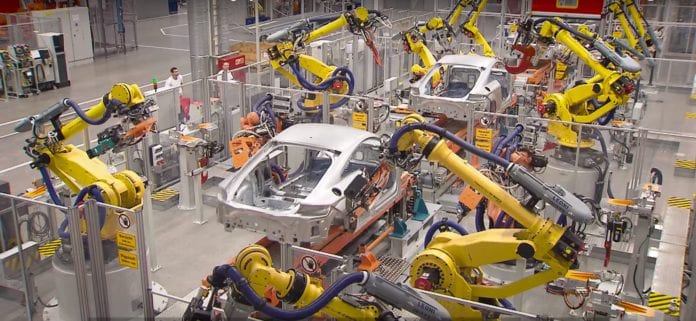What is lights out manufacturing?
“Lights out” manufacturing is the term used for a manufacturing process where factories run fully autonomously, without any human intervention. The term is quite literal, with production occurring free of human necessities like lighting or heating, ventilation and air conditioning (HVAC).

This differs from other fully-automated factories in that those often require some form of human interaction, whether it be a single team of engineers or a few people maintaining the robots on the floor. Lights out manufacturing exclusively refers to production where machines are entirely self-sufficient.
History
The idea of a fully autonomous factory isn’t new. In fact, the concept can be traced back to mid-century sci-fi novels. The 1955 post-apocalyptic story “Autofac” by Philip K. Dick features one of the earliest instances of self-producing machines, where humans are at the mercy of robots who decide what to produce and why. But the idea of a lights out factory hasn’t only been experimented with in fiction.
In 1982, General Motors (GM), under the direction of CEO Roger B. Smith, opened up the “factory of the future” in Saginaw, Michigan. Smith’s hope was to replace risk-averse bureaucracy with automation and robotics. A 1988 New York Times article titled Smart Machines, Smart Workers uses the term “lights out factory,” saying business owners had been disappointed by the results from the increasing reliance on the automated production line.
“As workers worried that they would be replaced by intelligent machines, engineers and executives spoke of the ‘lights out’ factory of the future, one automated enough to operate in the dark, unattended. But this enthusiastic reliance on highly automated production lines has been disappointing.”
General Motor’s “factory of the future” was given an obituary of sorts in a 1992 New York Times article, a decade after its opening. It never reached “lights out” status.
The same player, almost 30 years later
Former GM CEO Roger Smith was fixated on making his factories as efficient as those of his rivals in Japan, so he turned to Japanese robotics company FANUC (factory automation, numerical control). Now, nearly 30 years later, FANUC has evolved into what is arguably the most successful and well-known lights out factory in the world. It runs a complex that houses 22 factories with robots self-producing 22,000 to 23,000 computer numeric control machines per month. The company pledged $1 billion to expand its business in 2015, and has customers that include Tesla and Apple. In a 2003 article, CNN reported that FANUC’s robots can go unsupervised for as long as 30 days at a time.
“Not only is it lights out,” says FANUC vice president Gary Zywiol, “we turn off the air conditioning and heat too.”
Another fully autonomous operation that borders on “lights out” is Constellation Brands’ beer factory in Mexico. That facility runs with the help of only six humans per shift.
“It replaced forklifts and replaces the need for people to drive forklifts,” said Michael Othites, senior vice president of operations at Constellation Beer Division, in an interview with the Wall Street Journal. “We’ve got about 70 laser-guided vehicles. We would have 250 forklifts to do the same work. And frankly, laser-guided vehicles, when they need a battery change – they pull up and they say ‘change my battery.’ Employees need breaks, employees need lunches, employees call in sick. It’s just the human factor with the laser guided vehicle you don’t have.”
How it can be achieved with IoT
The internet of things is making “things” smart. It has already had a huge impact on industrial processes, from assisting with automation to detecting manufacturing faults. It is also making smart deployment less expensive through the use of small sensors and reliance on cloud-based software. An IoT solution can help make hardware faster, smarter and more reliable. If the widespread existence of lights out factories is to become a reality, it will almost certainly have IoT to thank.
But creating a lights out factory is not an easy task, and there are a number of considerations that need to be addressed before doing so. Production Machining made a list of topics to think about when transitioning to lights out, many of which can be answered with IoT solutions:
- Reliability of equipment
- Machine tools
- Chip and coolant management
- Material loading/unloading
- Planned preventative maintenance
- Remote monitoring
The good and the very bad
Bringing automated processes, or robots, to factories is already a reality. Machines getting rid of human jobs is something that has been occurring on a huge scale. The lights out factory, however, is something different altogether. From a business perspective, it can significantly reduce operational expenses (opex) after initially high capital expenditures (capex). It gets rid of wages, building expenses and loss due to human error. But, as seen decades ago with General Motors, it can present more problems than benefits.
Not having someone on site means machine failure can result in long periods of downtime, and huge losses.
A societal benefit of lights out is that it could amount in substantial energy savings. But the real question is what sort of impact replacing human labor with computers has on society. Many see the potential monetary benefits gained by companies as short of outweighing the detrimental impact joblessness has on individuals and society as a whole.
According to Natural News, the rise of automation is more likely to sharply divide the economic classes and cause widespread strife. “Those who are replaced by robots will become jobless and homeless. Those whose lives are enriched by the benefit of the robots will become abundantly wealthy in the material quality of their lives.”

